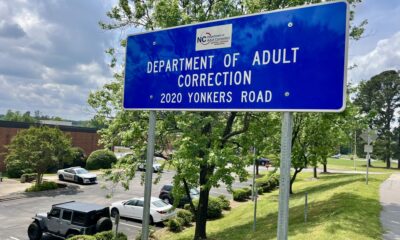News from the South - South Carolina News Feed
Former Republican congressman warns Trump’s tariffs could bring ‘severe consequences’
SUMMARY: Former President Trump announced aggressive new tariffs, calling it a “liberation day” for the U.S. and declaring economic independence. A baseline 10% tariff will apply to nearly all imports, with additional “discounted reciprocal tariffs” targeting countries like China. Trump argues this will boost American manufacturing and bring jobs back. However, critics, including a former Republican congressman, warn these measures could worsen inflation and risk a recession. Businesses say price hikes could hit consumers quickly. European nations plan retaliatory tariffs, and a Senate effort to curb Trump’s powers over Canadian goods is unlikely to succeed in the House.

During a Rose Garden signing ceremony Wednesday afternoon, President Donald Trump marked what he believed will be America’s “declaration of economic independence” by announcing an aggressive arsenal of tariffs he said will usher in a “golden age” of American manufacturing, but economists and many executives warn will exacerbate inflation and increase the odds of a recession.
“For American families that are sitting around the kitchen table trying to figure out their budgets, any disruption is a lot on them right now and there’s got to be some sensitivity to that,” said former Rep. Drew Ferguson, a Republican who completed his fourth term representing Georgia’s 3rd Congressional District earlier this year.
_______________
Stay up to date with our social media:
WPDE on Facebook: https://www.facebook.com/WPDEABC15/
WPDE on Twitter: https://twitter.com/wpdeabc15
Subscribe to WPDE on YouTube: https://www.youtube.com/channel/UCn0sxo5Ocp8eSFqr9F1URpg/?sub_confirmation=1
Daily News Playlist:
https://www.youtube.com/playlist?list=PLCFE982C7D59E70C1
For more information, visit https://wpde.com/
Have a news tip? Send it directly to us:
Email us: abc15news@wpde.com
Call the Newsroom: 843.487.3001
WPDE is a SC based station and an ABC Television affiliate owned and operated by Sinclair Broadcast Group. WWMB is a SC based station and a CW Television affiliate owned and operated by Howard Stirk Holdings and receives certain services from an affiliation of Sinclair Broadcast Group.
#WPDE #ABC15News #ABC15 #WPDE15 #MyrtleBeach #taxes #trending #trump #trumptaxes #taxcuts #tariffs #liberationday #finance #economy #recession
News from the South - North Carolina News Feed
Juvenile offenders often denied parole in NC prisons even as adults
A decade after a federal judge ordered North Carolina to adopt a plan to give juvenile offenders serving life sentences a “meaningful opportunity” for parole, a lawsuit making its way through the court system says the state has failed to follow through.
Earlier this month a judge denied the state’s motion to dismiss the suit, which was filed in 2023, noting “concerning” accounts of omitted and false information in plaintiff Brett Abrams’ parole file.
Abrams, 56, is serving a life sentence for murder at the minimum security prison in Hillsborough. He leaves prison five days a week to work a full-time job at a meat packing plant. In his 40 years of incarceration, he’s accrued 11 infractions, the last being in 2005.
On paper, he seems like a great candidate for parole. But the four-person commission that has sole discretion over parole decisions in North Carolina has denied him every time since he first became eligible in 1993.
Abrams has undergone two parole reviews since the state implemented its new process for juvenile offenders — colloquially known as the “Hayden Plan” for the case Hayden v. Keller that spurred its creation.
However, he continues to be denied his freedom.
A brutal killing
In 1983, Abrams stabbed and killed his 20-year old neighbor at her parents’ home after she confronted him for secretly watching her sunbathe. Abrams was 14 at the time of the slaying, and at 15 he was charged as an adult and sentenced to life imprisonment after pleading guilty to second-degree murder.
Depositions from Abrams’ lawsuit revealed his parole file had omitted crucial information that might have helped with his release. It also contained inaccurate information, including that he had an open homicide case against him for the 1982 death of his brother. In reality, the Iredell County Sheriffs’ Office had ruled the death an accident and closed the case.
“We saw in his profile pretty significant, very material mistakes that included misleading information, lies, things that were simply not true which we believe are so significant that it’s a sort of evidence in itself that the system is broken,” Abrams’ attorney, Jake Sussman, told Carolina Public Press.
And despite Abrams seeking psychological counseling and treatment based on the recommendation of the Parole Commission in 2018, those records were not included in his 2020 review.
“One would assume accurate and comprehensive summaries with relevant information would be essential where commissioners vote on more than 100 cases a day,” Judge Richard Myers wrote in his April 2 ruling.
The court cannot reverse the decisions made by the state’s Parole Commission, meaning the legality of Abrams’ continued incarceration is not being questioned. But Myers determined it is “within this court’s purview to review for Eighth Amendment violations,” as proven in Hayden v. Keller.
“What we’ve asked the judge to do is to find that the current system is unconstitutional as it applies to Mr. Abrams, and therefore as it would apply to all of the juvenile offenders, and develop a plan to actually have a review process that works,” Sussman said.
Juvenile offenders at mercy of the system
Decades of judicial rulings have given states plenty of discretion over how to handle the parole process.
North Carolina’s system has changed several times, and starting in 1994 the state eliminated parole altogether in favor of a different system called “structured sentencing,” which sets a minimum sentence and allows the Parole Commission to set the terms of release for felons once they reach that mark.
Those imprisoned prior to 1994 are still subject to the state’s older system, which Sussman described as a “constitutional mess,” particularly for juvenile offenders.
Two U.S. Supreme Court decisions from the 2010s — Graham v. Florida and Miller v. Alabama — resulted in monumental changes for people serving life sentences due to crimes they committed as juveniles. In those rulings, the Supreme Court severely limited states’ abilities to administer life sentences without parole to juvenile offenders, deciding that such actions constituted “cruel and unusual punishment” under the Eighth Amendment.
The logic behind that ruling is that juvenile offenders are more likely to respond to rehabilitation and reform compared to people imprisoned for crimes they committed later in life.
“Research in the area of brain development shows that the brain is not fully developed until about age 25,” explained Erin Fitzgerald, a professor at Elon University who specializes in juvenile justice. “This lack of development makes juveniles more impulsive, susceptible to peer pressure and unable to fully appreciate the consequences of their actions. However, it also makes them more malleable and capable of rehabilitation.”
Justice for juvenile offenders
The Hayden Plan at the center of Abrams’ lawsuit was born out of the precedent set by the Graham and Miller cases.
In 2010, a North Carolina inmate serving a life sentence for sexual assaults he committed as a teenager in the 1980s sued the Parole Commission for not giving him a fair chance to make his case for release.
His name was Shaun Hayden.
Every year after becoming eligible for parole, Hayden would receive the same letter from the commission saying that he had been denied parole, despite never having interacted with them in any way or being notified that he was up for review.
“He didn’t think that was fair, and he was correct,” said Ben Finholt, who was one of Hayden’s attorneys in his lawsuit against the commission. “It was a sham parole system where (the commission) never talked to anyone. They just review documents every year, and if not much changes, then you just get denied every year without them ever talking to you.”
A District Court ruled in Hayden’s favor, citing the U.S. Supreme Court’s decision in Graham v. Florida. The state lost its appeal and in 2018 was directed to implement a new plan for handling parole review for juvenile offenders.
That plan guaranteed juvenile offenders a 30-minute video conference with one of the commissioners, a specialized case analyst and, in the case of denial, a letter detailing why the inmate was denied parole and recommendations for future reviews.
New parole plan, old issues
The new plan hasn’t exactly led to substantive changes, however.
Finholt, who now serves as Abrams’ attorney for his parole review (separate from the lawsuit that Sussman is handling), has had a firsthand account of the Hayden Plan’s shortcomings.
“The parole case analyst in Brett’s case admitted under oath that she did not consider the advocacy letter that I wrote for Brett in 2020, that it was not part of the record and that she had made no changes to her process based on the fact that the person being considered for parole was a juvenile,” he said. “That is explicitly contrary to (the Hayden court’s) holding that people who were kids at the time of the crime are entitled constitutionally to a different process.”
That was one of the reasons Myers, the judge in Abrams’ lawsuit, denied the state’s motion to dismiss the suit.
However, Myers also wrote that it is “still unclear” based on the facts of the case whether the commissioners would have changed their decision on Abrams if the information in his file had been completely accurate.
He declined to rule in favor of either party and ordered more discovery on the matter. When that is completed in June, he may issue a final ruling or set a trial date.
Sussman said that if Abrams wins this lawsuit, he would advocate for a decision-making process that is less arbitrary, such as a rubric or points-based system.
Finholt has also advocated for such a change, and he said it makes sense regardless of people’s opinions regarding parole.
“My personal feeling, based on my long professional experience, is that most of the folks who are up for parole would do just fine outside of prison,” he said. “However, even if you’re a person who disagrees with me on that front, you should still dislike the current process because it’s not informed by any evidence or any data.
“If you’re the kind of person who thinks that most folks should stay inside, you should also be horrified by the fact that these release decisions are being made essentially on people’s guts.”
This article first appeared on Carolina Public Press and is republished here under a Creative Commons Attribution-NoDerivatives 4.0 International License.![]()
The post Arrest of Wisconsin judge ‘escalation’ in Trump-judiciary conflict, Democrats warn appeared first on tennesseelookout.com
Note: The following A.I. based commentary is not part of the original article, reproduced above, but is offered in the hopes that it will promote greater media literacy and critical thinking, by making any potential bias more visible to the reader –Staff Editor.
Political Bias Rating: Center-Left
The content presents a case focused on the rights of juvenile offenders, specifically in relation to parole decisions. The emphasis on rehabilitation, fairness in parole processes, and concerns over the accuracy and fairness of the system reflects a more progressive, or center-left, perspective. It advocates for juvenile offenders’ opportunity for parole based on their potential for reform, which aligns with broader left-leaning views on criminal justice reform and the belief in rehabilitation over punitive measures. The inclusion of legal cases like Graham v. Florida and Miller v. Alabama suggests an alignment with the idea of justice for juvenile offenders in line with constitutional protections. While the tone is not overtly political, the framing of the issues reflects concerns typically associated with progressive criminal justice reform.
News from the South - North Carolina News Feed
Lesson learned: How the pandemic provided a teachable moment for NC lawmakers in latest Helene relief bill
There’s going to be a full house in Ashe County’s public schools this summer. After a mix of bad weather and severe storms closed schools there for 47 days, Superintendent Eisa Cox plans to take full advantage of a Helene learning loss summer school program. It’s funded by the legislature in its most recent recovery bill.
The $9 million School Extension Learning Recovery Program is open to schools in 13 impacted Western North Carolina counties: Ashe, Avery, Buncombe, Burke, Haywood, Henderson, Madison, McDowell, Mitchell, Rutherford, Transylvania, Watauga and Yancey.
It covers grades 4 through 8 and focuses on intensive recovery in math and reading. Each participating school will receive at least $20,000 for the program and possibly double that, depending on how much state money is left over after all schools get initial funding.
While one of the lower-dollar items in the $524 million recovery package, the summer school program could mean a lot for Ashe County students. The school system already uses grant funding to run summer programs for various grades. Still, without state funds, having a “robust” learning loss program serving multiple grades in different schools would have been impossible, Cox said.
“That’s a hefty price in order to be able to do that for kids,” she said. “You’re talking about feeding them, transportation, the cost of the teacher over the summer, and, of course, you don’t want to put 30 kids in a class. That’s not going to achieve what you want for students who are already struggling to be on grade level.”
Helene learning loss overlooked — at first
While Gov. Josh Stein’s Helene recovery request included a summer learning loss program, the first version of the General Assembly’s Helene recovery bill didn’t offer a penny for public schools.
State Rep. Marcia Morey, D-Durham, took note. She recalled a retreat where she spoke with public school leaders from Western North Carolina who told her how “dire” the need was to get back in the classroom. Four years out, students were still recovering from pandemic learning loss. Helene only exacerbated the issue.
“We have eight counties. We have at least four schools (where) kids couldn’t go back — they had to go to other facilities,” she said in February on the House floor. “We have two schools totally decimated. And so we’re not doing it today, but our public school kids need a place to go. They need a facility. I hope in the next bill we will address the children out west in these affected counties.”
Morey tried to file an amendment to the legislature’s initial bill, but was told she was too late.
The next version of the bill included a $9 million summer learning program.
Morey said she wasn’t directly involved.
“I think they just knew they had to respond to it,” she told Carolina Public Press. “It was astounding that nothing was included in the first relief bill.”
Lessons from the pandemic
Not all missed school days are created equal. Losing one day could take a few hours, a day or a week to recover, depending on the grade level and subject matter.
For example, earlier grades typically learn a “mile wide” and an “inch deep,” covering a broader range of subjects than later grades, which tend to focus on one or two concepts, explained Jeni Corn, the impact evaluation and strategy director for the North Carolina Collaboratory.
This can make it harder for younger students to make up for lost time. Additionally, math concepts typically take longer to recover than those involving social studies.
The legislature first partnered with the North Carolina Collaboratory, housed at UNC-Chapel Hill, to research the impacts of the pandemic on K-12 education. Among the various studies was one looking at the effect of a state-funded summer school program designed to address pandemic learning loss.

That study now forms the basis of the Helene summer school program, Corn said.
Researchers found that higher summer school attendance correlated with better attendance the following academic year for students in grades 4 through 8 and seventh and eighth graders. They also discovered modest gains in math test scores among students who had high summer attendance, but no impact on reading scores.
Summer school programs can’t cure all learning loss, but they can improve student engagement through continued connection with their fellow peers and teachers, the researchers concluded.
Cox, the Ashe County superintendent, came to the same determination. A dozen days of summer school is never going to be enough time to recover from weeks of learning loss, but it can still help.
“When kids aren’t in school, they may not have a meal,” Cox said. “When kids are not in school, they may not have an adult around them during most of the day that can help them provide the structure to be able to read to them, to be able to provide them with direction.”
This article first appeared on Carolina Public Press and is republished here under a Creative Commons Attribution-NoDerivatives 4.0 International License.![]()
The post Lesson learned: How the pandemic provided a teachable moment for NC lawmakers in latest Helene relief bill appeared first on carolinapublicpress.org
Note: The following A.I. based commentary is not part of the original article, reproduced above, but is offered in the hopes that it will promote greater media literacy and critical thinking, by making any potential bias more visible to the reader –Staff Editor.
Political Bias Rating: Center-Left
The content presents information regarding a summer learning program in Western North Carolina aimed at addressing the educational impact of the pandemic, specifically referring to "Helene learning loss." The mention of lawmakers and educators collaborating to implement a state-supported program suggests a mildly progressive viewpoint, as it emphasizes government involvement in addressing educational challenges. Additionally, the sourcing from Carolina Public Press, described as an "independent newsroom" committed to uncovering overlooked issues, aligns with narratives often found in Center-Left media that advocate for social responsibility and public welfare initiatives. Overall, while the content is informative and not overtly biased, the context indicates a leaning towards Center-Left perspectives related to governance and education policy.
News from the South - North Carolina News Feed
Washington Regional expected to emerge from bankruptcy by May
Six months ago, Washington Regional Medical Center in Plymouth declared bankruptcy for the second time in five years. Now, hospital leadership hopes that the facility will emerge from this latest financial hardship by late May.
That’s good news to the 10,713 residents of Washington County who need the hospital to stay in business. It’s the only one around.
The bad news is that it has never been harder to keep a rural hospital afloat, especially one that’s not connected to a larger health system. In adjacent Martin County, Martin General Hospital closed its doors in 2023. Thirteen more counties in the northeastern region of the state don’t have hospitals at all.
Should Washington Regional get through this, it will serve as a rare example of a rural hospital taking control of its shaky finances and preserving essential services for North Carolinians.
The good doctor
When Washington Regional Medical Center filed for Chapter 11 bankruptcy, it owed millions to a long list of creditors.
Dominion Energy is due roughly $300,000. The Washington County Tax Office is asking for over $150,000. Washington Regional also owes money to General Electric as well as a number of vendors, including the company that handles the hospital’s pharmaceutical operations. The full list of creditors includes more than 70 companies and organizations.
Texas-based Affinity Health Partners purchased the Washington County hospital after a catastrophic 2019 bankruptcy that led to liquidation under its previous owners. But by the end of the year, patients were back on the hospital floor.
Washington County, one of the poorest areas in North Carolina, also hosts some of the highest rates of infant mortality and other adverse health conditions, such as obesity and heart disease.
That makes Washington Regional Medical Center, with its 25 beds, a lifeline in an otherwise barren health landscape. It’s why the facility is designated as a “critical access hospital” by the Centers for Medicare and Medicaid.
When neighboring Martin General Hospital closed, emergency room visitation at Washington Regional increased from 450 patients per month to over 600.
“The importance of the hospital cannot be overstated,” Plymouth Mayor Brian Roth told Carolina Public Press. “Especially since we’ve gotten all the patients who would have gone to Martin General.”
Washington Regional is ‘here to stay’
If Washington Regional did close, residents would have to drive hours to reach the nearest hospital — ECU Health Medical Center in Greenville. The flat, piney swampland on the Albemarle Sound is not easy to navigate, and public transit is pretty much nonexistent.
“We cannot lose the hospital here,” Roth said. “It just cannot happen.”
CEO Frank Avignone promises that it won’t.
“We used bankruptcy as a tool to reorganize our debt,” he explained. “We basically did it for one vendor who was giving us a hard time, and now that that is taken care of, the hospital is doing well. Patient volumes are up. We have a brand new CT scanner so we are increasing cardiac and pulmonary care. We have new doctors on staff. A new OB/GYN on staff. We’re not some fly-by-night community hospital being run by a crook using it as an ATM machine.
“The hospital is here to stay unless it burns to the ground.”
Washington Regional is not currently performing surgeries. Hospitals typically use specialty procedures as a way to generate revenue and offset the high costs of, say, operating an emergency room. The hope is that the hospital will renew surgical procedures at some point, adding a layer of financial security.
Meanwhile, another threat is looming: the $880 million cut to Medicaid currently being discussed by Republicans in Congress.
At Washington Regional Medical Center, 60% of patients are covered by Medicare or Medicaid, making the program a crucial source of funding for the hospital.
If that coverage goes away, the hospital’s finances may be thrown back into peril.
“We treat folks on Medicaid. That’s our population and that’s what we’re designed to do,” Avignone said. “We just have to balance the books. That’s what I’ve been trying to do — and it’s working.”
This article first appeared on Carolina Public Press and is republished here under a Creative Commons Attribution-NoDerivatives 4.0 International License.![]()
The post Washington Regional expected to emerge from bankruptcy by May appeared first on carolinapublicpress.org
Note: The following A.I. based commentary is not part of the original article, reproduced above, but is offered in the hopes that it will promote greater media literacy and critical thinking, by making any potential bias more visible to the reader –Staff Editor.
Political Bias Rating: Center-Left
This assessment considers the overall tone and context of the content. The article discusses the challenges faced by rural hospitals, particularly Washington Regional Medical Center, and highlights the importance of public health services like Medicaid for vulnerable populations. It presents a sympathetic view of the hospital’s financial struggles, linking them to broader public policy issues (e.g., potential cuts to Medicaid proposed by Republicans). The emphasis on social welfare and the vital role of community health services reflect a center-left perspective focused on the importance of public healthcare systems and support for low-income residents. However, the piece does not overly politicize the issue and maintains an informative, fact-based approach, which prevents it from being categorized as far-left.
-

 News from the South - Florida News Feed6 days ago
News from the South - Florida News Feed6 days agoJim talks with Rep. Robert Andrade about his investigation into the Hope Florida Foundation
-

 News from the South - Alabama News Feed4 days ago
News from the South - Alabama News Feed4 days agoPrayer Vigil Held for Ronald Dumas Jr., Family Continues to Pray for His Return | April 21, 2025 | N
-

 Mississippi Today5 days ago
Mississippi Today5 days ago‘Trainwreck on the horizon’: The costly pains of Mississippi’s small water and sewer systems
-

 News from the South - Texas News Feed5 days ago
News from the South - Texas News Feed5 days agoMeteorologist Chita Craft is tracking a Severe Thunderstorm Warning that's in effect now
-

 News from the South - Florida News Feed4 days ago
News from the South - Florida News Feed4 days agoTrump touts manufacturing while undercutting state efforts to help factories
-

 News from the South - Texas News Feed7 days ago
News from the South - Texas News Feed7 days agoNo. 3 Texas walks off No. 9 LSU again to capture crucial SEC softball series
-

 News from the South - Virginia News Feed5 days ago
News from the South - Virginia News Feed5 days agoTaking video of military bases using drones could be outlawed | Virginia
-

 Local News5 days ago
Local News5 days agoFamily comes from all around to celebrate Gulfport resident’s 100th birthday








































